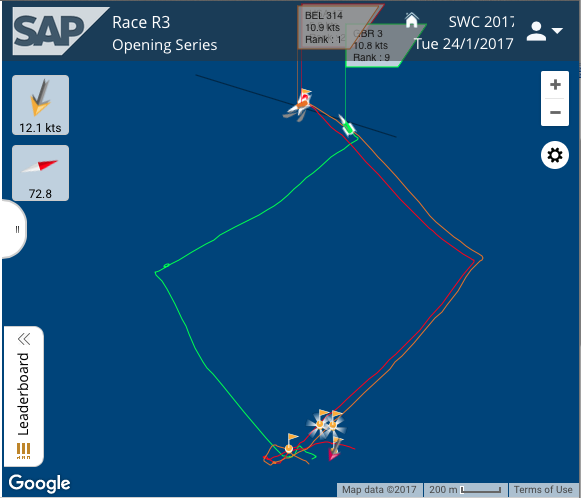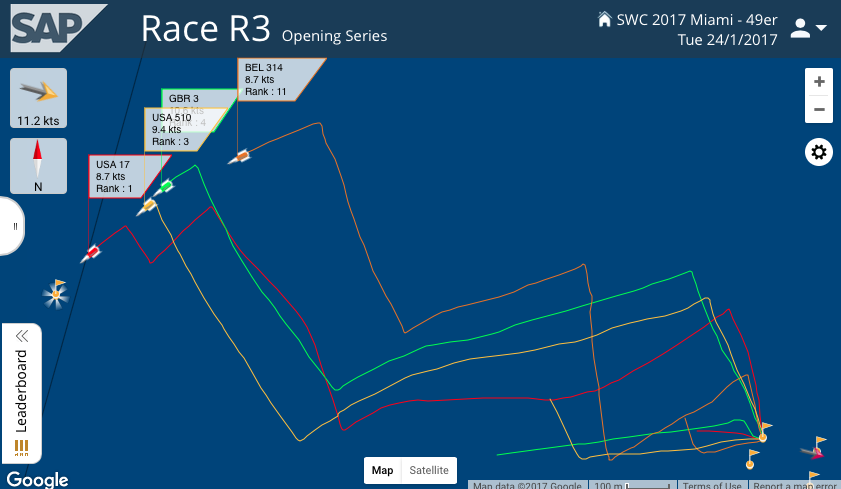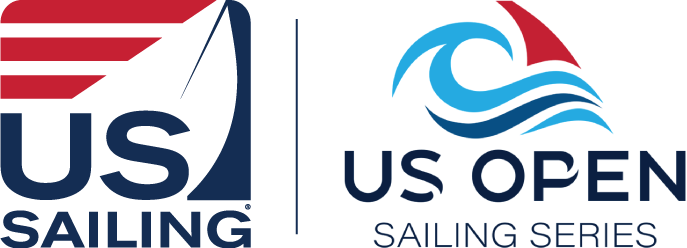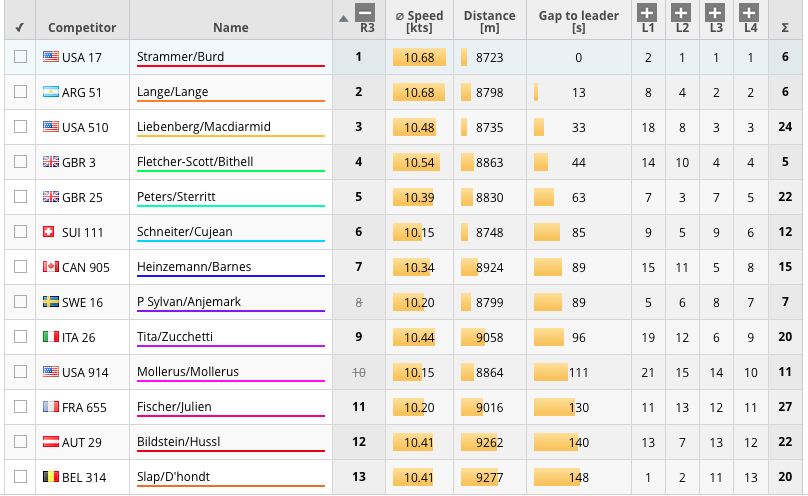SAP Deep Dive, 49er, Race 3: Short is Sweet
It’s tempting to think that because the 49er accelerates so quickly that the key to success on a puffy day is all about sailing in the best wind. Find the dark patches of water and send it.
However, a deep dive inside Race 3, using SAP’s Sailing Analytics, shows that one traditional tenet of the sport remains a constant even in the faster boats: The best path around the course is almost always the shortest.
The top five finishers in the race sailed an average distance of 8,787 meters while the bottom five sailed an average of 9,504, an increase of 7.5 percent.
 The solution to the first leg of the race was to bang the right corner. The Belgian team of Levi Slap and Joachim D’Hondt (orange track) rounded the first mark in the lead, trailed closely by Fred Strammer and Trevor Burd (red track), of the United States. Both boats started near the pin, got quickly on to port tack and one-tacked the beat. The British team of Dylan Fletcher-Scott and Stuart Bithell (lime green track), fresh off a win in Race 2, hit the left corner, found themselves on the outside of a right shift, and ended up sailing nearly 200 meters more than the lead boats, 2636 meters verses 2445 meters, on Leg 1. They rounded 14th.
The solution to the first leg of the race was to bang the right corner. The Belgian team of Levi Slap and Joachim D’Hondt (orange track) rounded the first mark in the lead, trailed closely by Fred Strammer and Trevor Burd (red track), of the United States. Both boats started near the pin, got quickly on to port tack and one-tacked the beat. The British team of Dylan Fletcher-Scott and Stuart Bithell (lime green track), fresh off a win in Race 2, hit the left corner, found themselves on the outside of a right shift, and ended up sailing nearly 200 meters more than the lead boats, 2636 meters verses 2445 meters, on Leg 1. They rounded 14th.
From that point on, for Strammer and Burd, it was a case of the rich getting richer. They executed a jibe set at the first mark and moved quickly into the lead, where they remained for the duration of the race.
The big comebacks of Race 3 came on the third leg from American crew of David Liebenberg and Ian MacDiarmid and Fletcher-Scott/Bithell, which rounded the first windward mark in 18th and 14th and the leeward gate in ninth and 10th, respectively.

This beat was a little more nuanced; teams that sailed relatively similar paths to the windward mark saw very different results. But the teams that did the best again sailed the least amount of distance.
Liebenberg and MacDiarmid (light orange) sailed 2,184 meters, Fletcher-Scott/Bithell, 2202. Strammer/Burd, 2257. Slap and D’Hondt, who went from second at the leeward mark—a position that should’ve enabled them to sail their own race—to 11th, sailed 2,530 meters, nearly a third of a kilometer more than the shortest solution to the leg.
Of course, it’s easy to dissect a race in hindsight and given the intense analysis possible with SAP’s analytics. In real time, while skimming across the water at 10 to 15 knots and hanging from a trapeze wire, it’s infinitely more difficult. And in a future race, it’s just as likely that the roles may be reversed, with Slap and D’Hondt executing the comeback, or leading at the first mark and never looking back. If predicting the breeze was easy, everyone would be doing it correctly. But the Deep Dive does further reinforce a lesson that is taught in Racing 101 and repeated often no matter what class or style of boat being sailed: when in doubt, keep the bow pointed as close to the mark as possible.


